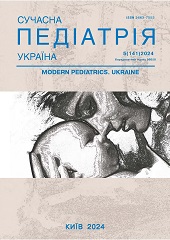Necrotizing enterocolitis in premature infants: the importance of risk factors in its development
DOI:
https://doi.org/10.15574/SP.2024.5(141).5559Keywords:
premature infants, necrotizing enterocolitis, risk factorsAbstract
Aim: to investigate the relationship between different risk factors and the neonatal development of necrotizing enterocolitis (NEC).
Material and methods. A prospective retrospective case-control study of premature infants with suspected of NEC in 2020-2021 was conducted. A total of 88 cases of preterm neonates with suspected NEC and 30 preterm neonates in the control group were identified and analyzed. NEC diagnosis was performed in 29 (32.5%) infants. The collected variables included pregnancy- and maternal-related risk factors, physical developmental indicators of infants, Apgar score, mechanical ventilation, mode and type of delivery, sex of infants. Statistical processing of indicators was carried out in the Windows SPSS20 system. Differences at p˂0.05 were considered reliable.
Results. A relationship between the number of pregnancies and NEC in preterm infants was found. The birth of a newborn from the 3rd-4th pregnancy increased the risk of NEC development (p=0.001). In babies whose diagnosis of NEC is not confirmed, the height was 38.9±0.5 sm (min 30, max 47); with a confirmed diagnosis of NEC, it was 41.2±0.7 cm (min 34, max 48) (p=0.019).
Conclusions. The factors recognized by this case-control study that increased the risk of neonatal NEC contained heterogeneity. There were no significant differences in terms of other maternal, pregnancy and neonatal risk factors in the development of NEC.
The research was carried out in accordance with the principles of the Declaration of Helsinki. The research protocol was approved by the Ethics Committee of Azerbaijan Medical University. The informed consent of the patient was obtained for conducting the studies.
No conflict of interests was declared by the authors.
References
Ahle M, Drott P, Elfvin A et al. (2018). Maternal, fetal and perinatal factors associated with necrotizing enterocolitis in Sweden. A national case-control study. 13(3): 0194352. https://doi.org/10.1371/journal.pone.0194352
Alsaied A, Islam N, Thalib L. (2020). Global incidence of Necrotizing Enterocolitis: a systematic review and Meta-analysis. BMC Pediatr. 20(1): 344. https://doi.org/10.1186/s12887-020-02231-5
Arnold M, Moore SW, Sidler D et al. (2010). Long-term outcome of surgically managed necrotizing enterocolitis in a developing country. Pediatric Surgery International. 26(4): 355-360. https://doi.org/10.1007/s00383-010-2583-8
Berkhout DJC, Klaassen P, Niemarkt HJ et al. (2018). Risk Factors for Necrotizing Enterocolitis: A Prospective Multicenter Case-Control Study Subject Area: Women's and Children's Health. Neonatology. 114(3): 277-284. https://doi.org/10.1159/000489677
Cho H, Lee EH, Lee KS, Heo JS. (2022). Machine learning-based risk factor analysis of necrotizing enterocolitis in very low birth weight infants. Scientific Reports. 12(1): 21407. https://doi.org/10.1038/s41598-022-25746-6
Feng B, Zhang Z, Wei Q, Mo Y et al. (2023). A prediction model for neonatal necrotizing enterocolitis in preterm and very low birth weight infants. Front Pediatr. 11: 1242978. https://doi.org/10.3389/fped.2023.1242978
Fullerton BS, Hong CR, Velazco CS, Mercier CE, Morrow KA, Edwards EM et al. (2017, Oct). Severe neurodevelopmental disability and healthcare needs among survivors of medical and surgical necrotizing enterocolitis: A prospective cohort study. J Pediatr Surg. 12: S0022-3468(17)30651-6. Epub ahead of print. PMID: 29079317. https://doi.org/10.1016/j.jpedsurg.2017.10.029
Gephart SM, Jacqueline MM, Effken JA. (2012). Necrotizing Enterocolitis Risk. Adv Neonatal Care. 12(2): 77-89. https://doi.org/10.1097/ANC.0b013e31824cee94
Gitau K, Ochieng R, Limbe M, Kathomi C, Orwa J. (2023, Dec). The incidence and modifiable risk factors for necrotizing enterocolitis in preterm infants: a retrospective cohort study. J Matern Fetal Neonatal Med. 36(2): 2253351. PMID: 37648650. https://doi.org/10.1080/14767058.2023.2253351
Lee JY, Park KH, Kim A et al. (2017). Maternal and Placental Risk Factors for Developing Necrotizing Enterocolitis in Very Preterm Infants Pediatrics & Neonatology. 58(1): 57-62. https://doi.org/10.1016/j.pedneo.2016.01.005
March MI, Gupta M, Modest AM. (2015). Maternal Risk Factors for Neonatal Necrotizing Enterocolitis. J Matern Fetal Neonatal Med. 28(11): 1285-1290. https://doi.org/10.3109/14767058.2014.951624
Markel TA, Engelstad H, Poindexter BB. (2014). Predicting Disease Severity of Necrotizing Enterocolitis: How to Identify Infants for Future Novel Therapies. J Clin Neonatol. 3(1): 1-9. https://doi.org/10.4103/2249-4847.128717
Neu J, Walker WA. (2011). Necrotizing Enterocolitis. N Engl J Med. 364(3): 255-264. https://doi.org/10.1056/NEJMra1005408
Patel S, Dammann O, Martin CR et al. (2011). Presumed and definite bacteremia in extremely low gestational age newborns. Acta Paediatr. 100(1): 36-41. https://doi.org/10.1111/j.1651-2227.2010.01963.x
Perger L, Komidar L, Mukhopadhyay D et al. (2016). Maternal pre-eclampsia as a risk factor for necrotizing enterocolitis. J Matern Fetal Neonatal Med. 29(13): 2098-2103. https://doi.org/10.3109/14767058.2015.1076386
Samuels N, van de Graaf RA, de Jonge RCJ et al. (2017). Risk factors for necrotizing enterocolitis in neonates: a systematic review of prognostic studies. BMC Pediatr. 17(1): 105. https://doi.org/10.1186/s12887-017-0847-3
Su Y, Xu RH, Guo LY, Chen XQ, Han WX, Ma JJ et al. (2023. Jan 6). Risk factors for necrotizing enterocolitis in neonates: A meta-analysis. Front Pediatr. 10: 1079894. PMID: 36683790; PMCID: PMC9853297. https://doi.org/10.3389/fped.2022.1079894
Downloads
Published
Issue
Section
License
Copyright (c) 2024 Modern pediatrics. Ukraine

This work is licensed under a Creative Commons Attribution-NonCommercial 4.0 International License.
The policy of the Journal “MODERN PEDIATRICS. UKRAINE” is compatible with the vast majority of funders' of open access and self-archiving policies. The journal provides immediate open access route being convinced that everyone – not only scientists - can benefit from research results, and publishes articles exclusively under open access distribution, with a Creative Commons Attribution-Noncommercial 4.0 international license (СС BY-NC).
Authors transfer the copyright to the Journal “MODERN PEDIATRICS. UKRAINE” when the manuscript is accepted for publication. Authors declare that this manuscript has not been published nor is under simultaneous consideration for publication elsewhere. After publication, the articles become freely available on-line to the public.
Readers have the right to use, distribute, and reproduce articles in any medium, provided the articles and the journal are properly cited.
The use of published materials for commercial purposes is strongly prohibited.

